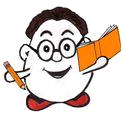Simple machines do not require any electrical or complex parts. They are used to make work easier. The following are simple machines: levers, wedges, pulleys, inclined planes, wheels, and screws.
Additional Facts:
1.
Types of energy:
Electrical energy - Energy that comes from electrical currents.
Solar energy - Energy that comes from the Sun's heat.
Chemical energy - Energy that comes from combining two or more. substances
Wind energy - Energy that comes from windmills and turbines.
Hydroelectric energy - Energy that comes from rivers, lakes, and other water sources.
Nuclear energy - Energy that comes from joining two atoms together.
The formula that expresses the amount of work that is being done is:
Work = Force x Distance
Suppose a person lifts an object that weighs 40 pounds 3 feet from the floor.
You can determine the amount of work that is being done by plugging the information that we have already into the formula.
This tells us that the person has done 120 pounds of work.
Work = Force x Distance
120 pounds = 40 pounds x 3 feet
2.
3.
4.
 | ||||
 | ||||
 | ||||
 | ||||
 | ||||
 | ||||
a particle that represents the smallest amount of
light and travels at the speed of light because it has no mass
Albert Einstein's theory regarding the relationship of matter, time, and space shows how mass and energy are equal, and that mass, length, and time change with speed
photons
relativity
 | ||||
 | ||||
 | ||||
 | ||||
 | ||||
 | ||||
the amplified vibration of one object at the same natural frequency of a second object forces the second object to vibrate
gravity
the number of a repeated event per unit of time
it shows the presence of energy in an environment
frequency
force
the measure of how much twisting force on an object causes the object to rotate
torque
 | ||||
 | ||||
 | ||||
 | ||||
 | ||||
 | ||||
the measure of the amount of substance based on an object's resistance to change
the amount of time in which work is done
mass
power
 | ||||
 | ||||
 | ||||
 | ||||
 | ||||
 | ||||
the law of motion that demonstrates an example of a ball that is moved from its resting place because it was pushed during contact made by another ball
law of inertia
the law of motion that demonstrates an example of while a person is swimming, the person pushes the water backward as the water pushes the person forward
the law of motion that demonstrates an example of the force of the wind that blows through the wind chimes, causing the chimes to ring
law of action and reaction
law of applied force
the capacity to do work
energy
 | ||||
 | ||||
 | ||||
 | ||||
 | ||||
 | ||||
energy that is being used
kinetic energy
resonance
the force that pulls an object towards the center of the earth
energy that is being stored
potential energy
Science: Kinetic and Potential Energy - Flashcards
Use the flashcards to help you memorize the following terms and definitions. Then try the worksheets shown on the Science Homepage. Once you are ready to quiz yourself, click the Quiz link.
